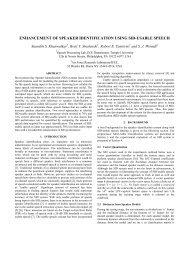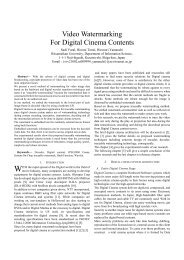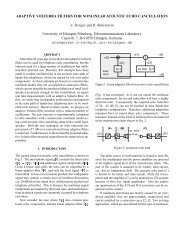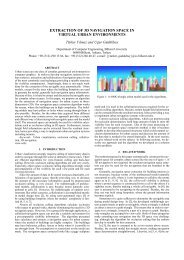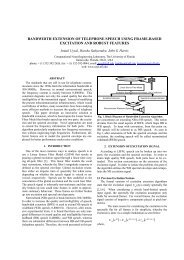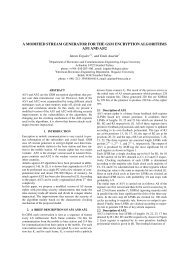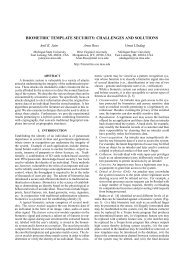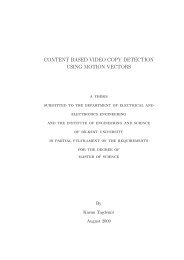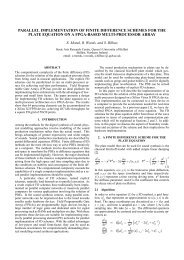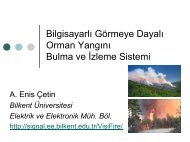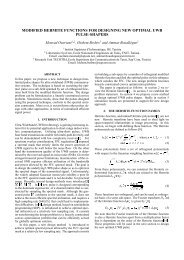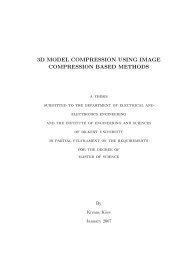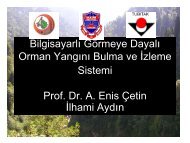performance evaluation of image segmentation. application to ...
performance evaluation of image segmentation. application to ...
performance evaluation of image segmentation. application to ...
Create successful ePaper yourself
Turn your PDF publications into a flip-book with our unique Google optimized e-Paper software.
PERFORMANCE EVALUATION OF IMAGE SEGMENTATION.<br />
APPLICATION TO PARAMETERS FITTING<br />
S. Chabrier, H. Laurent and B. Emile<br />
Labora<strong>to</strong>ire Vision et Robotique - UPRES EA 2078<br />
ENSI de Bourges - Université d’Orléans<br />
10 boulevard Lahi<strong>to</strong>lle, 18020 Bourges Cedex, France<br />
phone: +33 2248484000, fax: +33 2248484040<br />
email:sebastien.chabrier@ensi-bourges.fr<br />
ABSTRACT<br />
This paper deals with the <strong>performance</strong> <strong>evaluation</strong> <strong>of</strong> <strong>image</strong><br />
<strong>segmentation</strong>. The goal <strong>of</strong> this work is <strong>to</strong> show some techniques<br />
that enable the comparison <strong>of</strong> different <strong>segmentation</strong><br />
results. We first present a visualization method that facilitates<br />
the visual <strong>evaluation</strong> <strong>of</strong> a <strong>segmentation</strong> result. Next, we<br />
focus on unsupervised <strong>evaluation</strong> criteria that do not take in<strong>to</strong><br />
account any a priori knowledge <strong>to</strong> quantify the quality <strong>of</strong> a<br />
<strong>segmentation</strong> result. Finally, we use these <strong>evaluation</strong> criteria<br />
<strong>to</strong> determine the best fitted parameters <strong>of</strong> a <strong>segmentation</strong><br />
method for a given <strong>image</strong> and a desired level <strong>of</strong> precision.<br />
1. INTRODUCTION<br />
Segmentation is one <strong>of</strong> the first step in an <strong>image</strong> analysis<br />
process and is <strong>of</strong> crucial importance. The goal is there <strong>to</strong> decompose<br />
the <strong>image</strong> in homogeneous regions in order <strong>to</strong> facilitate<br />
the scene interpretation which is done afterwards. That<br />
is why many <strong>segmentation</strong> methods have been proposed for<br />
the last years [1], [2], [8] ... The multitude <strong>of</strong> the available<br />
information in this domain is at once very attractive but also<br />
destabilizing for the user who is <strong>of</strong>ten placed in a tricky position<br />
in front <strong>of</strong> this prolific literature. It indeed remains difficult<br />
<strong>to</strong> evaluate the <strong>segmentation</strong> methods efficiency and <strong>to</strong><br />
fix ones’s choice on a single method, no one being optimal in<br />
all cases. We present in this communication two approaches<br />
that allow <strong>to</strong> evaluate the quality <strong>of</strong> a <strong>segmentation</strong> result and<br />
that can make the choice easier for an user.<br />
In the first part <strong>of</strong> this article, we present a method that<br />
facilitates the visual <strong>evaluation</strong> <strong>of</strong> a <strong>segmentation</strong> result by<br />
using a colored representation. The classical presentation <strong>of</strong><br />
different <strong>segmentation</strong> results in the grey-level domain <strong>of</strong>ten<br />
makes it difficult <strong>to</strong> compare their respective <strong>performance</strong>s.<br />
The human eye is indeed incapable <strong>to</strong> distinguish between<br />
close grey levels. The change <strong>to</strong> the color domain mainly<br />
allows us <strong>to</strong> overcome this human limitation.<br />
In a second part, we focus on unsupervised <strong>evaluation</strong><br />
criteria allowing <strong>to</strong> quantify the quality <strong>of</strong> a <strong>segmentation</strong><br />
result by considering different statistics without any a priori<br />
knowledge. Lots <strong>of</strong> <strong>evaluation</strong> criteria have been proposed in<br />
the literature <strong>to</strong> quantify the quality <strong>of</strong> a <strong>segmentation</strong> result<br />
[5], [7], [11] ... These criteria can be applied <strong>to</strong> many <strong>application</strong>s<br />
such as the comparison <strong>of</strong> <strong>segmentation</strong> methods<br />
or the choice <strong>of</strong> the best fitted parameters <strong>of</strong> a <strong>segmentation</strong><br />
method for a given <strong>image</strong>. We compared in [3] six unsupervised<br />
criteria on uniform, textured and mixed, synthetic and<br />
The authors would like <strong>to</strong> thank financial support provided by the Conseil<br />
Régional du Centre and the European union (FSE).<br />
real <strong>image</strong>s. This study showed that two criteria seem <strong>to</strong> be<br />
the most relevant ones. The first one is favorably applied <strong>to</strong><br />
textured <strong>image</strong>s [9] and the other one is more adapted for<br />
uniform and low textured <strong>image</strong>s [10]. In this article, we<br />
illustrate in a real case concerning aerial <strong>image</strong>s processing,<br />
the interest <strong>of</strong> the two, above mentionned, unsupervised <strong>evaluation</strong><br />
criteria for <strong>segmentation</strong> method grading.<br />
Finally, some conclusions and perspectives are given.<br />
2. VISUAL EVALUATION OF A SEGMENTATION<br />
RESULT<br />
After having segmented a gray-level <strong>image</strong> by using different<br />
methods or a single one with different parameters, one<br />
has generally <strong>to</strong> determine which is the most satisfac<strong>to</strong>ry result.<br />
If some <strong>evaluation</strong> criteria can guide the user in his<br />
decision, it can be comfortable <strong>to</strong> be able <strong>to</strong> visually assess<br />
the results. We address and illustrate here the difficulty <strong>of</strong><br />
the visual comparison <strong>of</strong> different <strong>segmentation</strong> results <strong>of</strong> an<br />
<strong>image</strong>. The EDISON algorithm [4] and a classical fuzzy C-<br />
means algorithm (FCM) [6] are used for this example.<br />
One usual method <strong>to</strong> visualize a <strong>segmentation</strong> result is <strong>to</strong><br />
attribute <strong>to</strong> each detected region the gray level corresponding<br />
<strong>to</strong> the average value <strong>of</strong> all pixels composing the region<br />
in the original <strong>image</strong>. As shown in figure 1, this method allows<br />
a good visual representation <strong>of</strong> a <strong>segmentation</strong> result.<br />
Nevertheless, when two adjacent regions have similar average<br />
value, it can become difficult <strong>to</strong> evaluate the quality <strong>of</strong><br />
the <strong>segmentation</strong> result. The human eye is indeed not able<br />
<strong>to</strong> distinguish two regions with very close gray levels, the<br />
different regions can then seem <strong>to</strong> form a whole.<br />
In order <strong>to</strong> overcome this problem, it is also possible <strong>to</strong><br />
use a second colored <strong>image</strong> <strong>to</strong> display the <strong>segmentation</strong> result.<br />
Each region is represented with a random color chosen<br />
in a colormap uniformly spread among the RGB one. Let N R<br />
be the number <strong>of</strong> regions <strong>of</strong> the <strong>image</strong> <strong>to</strong> be colored, the N R<br />
color palette is first created. Each color is then randomly attributed<br />
<strong>to</strong> one region. This second <strong>image</strong> allows, as shown<br />
in figure 2, <strong>to</strong> clearly distinguish the borders <strong>of</strong> the regions.<br />
Nevertheless, the same <strong>segmentation</strong> result presented<br />
with two random palettes can appear very different (see figure<br />
3). If the proposed procedure is independently applied <strong>to</strong><br />
two <strong>segmentation</strong> results, it will be, in that case, difficult <strong>to</strong><br />
compare them.<br />
To solve this problem, we propose a color matching procedure<br />
<strong>to</strong> make the visual assessment easier. We first apply<br />
the above mentioned coloring procedure <strong>to</strong> the <strong>segmentation</strong><br />
result composed <strong>of</strong> the highest number <strong>of</strong> regions. We then<br />
obtain the reference colormap and the colored representation
the <strong>segmentation</strong> results <strong>of</strong> figure 1. It becomes, in that case,<br />
much easier <strong>to</strong> visually pair the regions and <strong>to</strong> compare the<br />
quality <strong>of</strong> the different <strong>segmentation</strong> results.<br />
(a) Original<br />
(a) Edison<br />
(b) Edison<br />
Figure 3: Random coloring : (a) First colored result (Edison<br />
<strong>segmentation</strong>) - (b) Second colored result (Edison <strong>segmentation</strong>)<br />
(b) Edison<br />
(c) FCM<br />
Figure 1: Mean-gray level representations : (a) Original<br />
<strong>image</strong> - (b) Segmentation by the Edison algorithm - (c) Segmentation<br />
by fuzzy C-means (FCM)<br />
(a) Edison<br />
(b) FCM<br />
Figure 4: Matched coloring : (a) Colored result (FCM <strong>segmentation</strong>)<br />
- (b) Matched colored result (Edison <strong>segmentation</strong>)<br />
(a) Edison<br />
(b) Edison<br />
Figure 2: Mean-gray level and colored representations:<br />
(a) Gray-level result (Edison <strong>segmentation</strong>) - (b) Colored result<br />
(Edison <strong>segmentation</strong>)<br />
: I re f . For each <strong>segmentation</strong> result left I k , we search the region<br />
R <strong>of</strong> I k having the highest intersection with a region X<br />
<strong>of</strong> I re f and color this region R with the color <strong>of</strong> X. This color<br />
is then declared unusable and the process is repeated until no<br />
region <strong>of</strong> I k has common pixels with one left region <strong>of</strong> I re f .<br />
Finally, if some regions <strong>of</strong> I k remain unpaired, they are randomly<br />
colored, taking one color among the I re f unused ones.<br />
Figure 4 presents the colored visualizations corresponding <strong>to</strong><br />
3. UNSUPERVISED EVALUATION CRITERIA<br />
We focus in this part on unsupervised <strong>evaluation</strong> criteria that<br />
enable <strong>to</strong> quantify the quality <strong>of</strong> a <strong>segmentation</strong> result without<br />
any a priori knowledge. Six unsupervised <strong>evaluation</strong> criteria<br />
<strong>of</strong> <strong>segmentation</strong> results had been compared in a previous<br />
work [3] (Zeboudj, Inter, Intra, Intra-inter, Borsotti and<br />
Rosenberger). A database including 300 synthetic <strong>image</strong>s<br />
composed <strong>of</strong> textured and uniform regions was used for the<br />
comparison. This study revealed that two criteria seem <strong>to</strong><br />
give better results than others: Zeboudj [10] and Rosenberger<br />
[9] criteria. Each criterion is more adapted for a type <strong>of</strong> <strong>image</strong>.<br />
Zeboudj’s contrast is more adapted for uniform <strong>image</strong>s,<br />
while Rosenberger’s criterion is more relevant <strong>to</strong> textured <strong>image</strong>s.<br />
We illustrate in this paper the interest <strong>of</strong> these two criteria<br />
for the fitting <strong>of</strong> parameters <strong>of</strong> a <strong>segmentation</strong> method.<br />
• Zeboudj’s contrast (Zeboudj) : [10]<br />
This contrast takes in<strong>to</strong> account interior contrast and external<br />
contrast <strong>of</strong> the regions in the neighborhood <strong>of</strong> each<br />
pixel. If we note W(s) a neighborhood <strong>of</strong> a pixel s, f (s)
the pixel intensity and L the maximum intensity, the contrast<br />
inside (I i ) and with outside (E i ) <strong>of</strong> the region R i are<br />
respectively :<br />
I i = 1 A i s∈R i<br />
max{c(s,t),t ∈ W(s) ∩ R i } (1)<br />
E i = 1 l i s∈F i<br />
max{c(s,t),t ∈ W(s),t /∈ R i } (2)<br />
where A i is the surface and F i is the border (<strong>of</strong> length l i )<br />
<strong>of</strong> the region R i . The contrast <strong>of</strong> R i is :<br />
⎧<br />
⎪⎨ 1 − I i<br />
E i<br />
if 0 < I i < E i<br />
C(R i ) = E i if I i = 0<br />
(3)<br />
⎪⎩<br />
0 otherwise<br />
The global contrast is :<br />
C zeboud j = 1 A i<br />
A i C(R i ). (4)<br />
• Rosenberger’s criterion (Rosenberger) : [9]<br />
The originality <strong>of</strong> this criterion lies in its adaptive computation<br />
according <strong>to</strong> the type <strong>of</strong> region (uniform or textured).<br />
In the textured case, the dispersion <strong>of</strong> some textured<br />
parameters is used and in the uniform case, graylevels<br />
statistics are computed.<br />
The contrast function is calculated as follow :<br />
C Rosenberger =<br />
D(I) + 1 − D(I)<br />
2<br />
(5)<br />
where D(I) corresponds <strong>to</strong> the global intra-class disparity<br />
that quantify the homogeneity <strong>of</strong> each region <strong>of</strong> <strong>image</strong> I,<br />
and D(I) corresponds <strong>to</strong> the global inter-class disparity<br />
that quantify the global disparity <strong>of</strong> each region <strong>of</strong> <strong>image</strong><br />
I.<br />
4. APPLICATION TO PARAMETERS FITTING<br />
We show in this section an <strong>application</strong> <strong>of</strong> the previous <strong>evaluation</strong><br />
criteria for the fitting <strong>of</strong> parameters <strong>of</strong> a <strong>segmentation</strong><br />
method. In general, one has <strong>to</strong> set the level <strong>of</strong> precision <strong>of</strong><br />
the <strong>segmentation</strong> method by adjusting the parameters <strong>of</strong> the<br />
method <strong>to</strong> obtain the number <strong>of</strong> classes or regions in the <strong>segmentation</strong><br />
result. The goal <strong>of</strong> this work is <strong>to</strong> be able <strong>to</strong> determine<br />
au<strong>to</strong>matically the best parameters <strong>of</strong> a <strong>segmentation</strong><br />
method <strong>to</strong> reach a given level <strong>of</strong> precision. In order <strong>to</strong> quantify<br />
the level <strong>of</strong> precision <strong>of</strong> a <strong>segmentation</strong> result, we choose<br />
<strong>to</strong> consider the number <strong>of</strong> regions in the <strong>segmentation</strong> result.<br />
We use for this <strong>application</strong> the EDISON algorithm [4]<br />
and we try <strong>to</strong> determine the best values <strong>of</strong> two parameters<br />
(spatial and range bandwidth) <strong>to</strong> segment two aerial <strong>image</strong>s<br />
at different levels <strong>of</strong> precision (see figure 5(a), 6(a)). We segmented<br />
these two <strong>image</strong>s with 8 values <strong>of</strong> the spatial bandwidth<br />
(from 3 <strong>to</strong> 17 with a step <strong>of</strong> 2) and 11 values <strong>of</strong> the<br />
range bandwidth (from 2 <strong>to</strong> 31 with a step <strong>of</strong> 3). So, we<br />
obtained 88 <strong>segmentation</strong> results for each <strong>image</strong>.<br />
We defined three types <strong>of</strong> <strong>segmentation</strong> results by considering<br />
the number <strong>of</strong> detected regions :<br />
• precise <strong>segmentation</strong> results : <strong>segmentation</strong> results with<br />
a number <strong>of</strong> regions between 60 and 90,<br />
• intermediate <strong>segmentation</strong> results : <strong>segmentation</strong> results<br />
with a number <strong>of</strong> regions between 20 and 40,<br />
• coarse <strong>segmentation</strong> results : <strong>segmentation</strong> results with a<br />
number <strong>of</strong> regions between 5 and 10.<br />
We show in table 1 the value <strong>of</strong> the Zeboudj’s contrast<br />
computed for the different <strong>segmentation</strong> results obtained for<br />
each value <strong>of</strong> the two previous parameters on the <strong>image</strong> presented<br />
in figure 5(a) (uniform <strong>image</strong>).<br />
Spatial ❵❵❵❵❵❵<br />
3 5 7 9 11 13 15 17<br />
Range<br />
2 0,53 0,54 0,54 0,53 0,53 0,53 0,55 0,54<br />
5 0,56 0,57 0,56 0,54 0,54 0,53 0,55 0,54<br />
8 0,59 0,55 0,58 0,54 0,52 0,5 0,53 0,54<br />
11 0,59 0,52 0,54 0,53 0,51 0,51 0,52 0.51<br />
14 0,49 0,49 0,48 0,49 0,49 0,47 0,44 0,44<br />
17 0,01 0,09 0,35 0,47 0,49 0,44 0,44 0,42<br />
20 0,01 0,01 0 0,35 0,35 0,14 0,41 0,39<br />
23 0 0 0 0,30 0,02 0,02 0,07 0,03<br />
26 0 0 0 0 0,03 0,03 0,03 0<br />
29 0 0 0 0 0 0 0 0<br />
31 0 0 0 0 0 0 0 0<br />
Table 1: Evolution <strong>of</strong> the Zeboudj’s contrast for each value<br />
<strong>of</strong> spatial bandwidth (column) and range bandwidth (row) by<br />
using the EDISON algorithm on the uniform <strong>image</strong>.<br />
Table 2 gives the number <strong>of</strong> regions <strong>of</strong> the different <strong>segmentation</strong><br />
results. This information allows us <strong>to</strong> determine<br />
the level <strong>of</strong> precision <strong>of</strong> each <strong>segmentation</strong> result.<br />
Spatial ❵❵❵❵❵❵<br />
Range<br />
3 5 7 9 11 13 15 17<br />
2 86 85 82 90 86 82 73 75<br />
5 70 63 60 50 46 45 38 37<br />
8 41 41 36 28 35 25 17 24<br />
11 27 21 22 20 18 12 13 10<br />
14 16 15 13 14 13 10 8 7<br />
17 5 7 8 11 9 5 8 5<br />
20 5 4 4 7 6 3 6 6<br />
23 3 2 2 8 4 5 4 2<br />
26 1 6 1 1 2 2 2 2<br />
29 1 2 1 1 1 1 1 3<br />
31 3 1 1 1 1 1 1 1<br />
Table 2: Number <strong>of</strong> regions for each value <strong>of</strong> spatial bandwidth<br />
(column) and range bandwidth (row) by using the EDI-<br />
SON algorithm on the uniform <strong>image</strong>.<br />
In order <strong>to</strong> facilitate the understanding <strong>of</strong> these tables, we<br />
put in<strong>to</strong> obviousness each type <strong>of</strong> <strong>segmentation</strong> result with a<br />
different gray level (black : precise result, dark gray : intermediate<br />
result and light gray : coarse result). When the value<br />
<strong>of</strong> the range bandwidth parameter becomes important, the<br />
Zeboudj’s contrast has a value equal <strong>to</strong> 0, meaning that the<br />
<strong>segmentation</strong> result is very bad. That makes sense because<br />
in these cases, there are only one or two detected regions.
For each type <strong>of</strong> <strong>segmentation</strong> result, we choose the parameters<br />
maximizing the <strong>evaluation</strong> criterion adapted for the<br />
type <strong>of</strong> <strong>image</strong>. For uniform <strong>image</strong>s, we choose the Zeboudj’s<br />
contrast and for textured <strong>image</strong>s, the Rosenberger’s criterion.<br />
We present in figures 5, 6 <strong>segmentation</strong> results obtained by<br />
using the parameters maximizing the criterion for each original<br />
<strong>image</strong> and by using the coloring method described in<br />
section 2. These <strong>segmentation</strong> results are visually coherent<br />
for each level <strong>of</strong> precision.<br />
(a) <strong>image</strong> 3 (b) result 1<br />
(a) <strong>image</strong> 1 (b) result 1<br />
(c) result 2 (d) result 3<br />
Figure 6: Optimal <strong>segmentation</strong> results <strong>of</strong> a textured <strong>image</strong><br />
: (a) textured <strong>image</strong> - (b) precise <strong>segmentation</strong> - (c) intermediate<br />
<strong>segmentation</strong> - (d) coarse <strong>segmentation</strong>.<br />
(c) result 2 (d) result 3<br />
Figure 5: Optimal <strong>segmentation</strong> results <strong>of</strong> an uniform <strong>image</strong><br />
: (a) uniform <strong>image</strong> - (b) precise <strong>segmentation</strong> - (c) intermediate<br />
<strong>segmentation</strong> - (d) coarse <strong>segmentation</strong>.<br />
5. CONCLUSION AND PERSPECTIVES<br />
We presented in this paper different techniques that allow<br />
the comparison <strong>of</strong> different <strong>segmentation</strong> results <strong>of</strong> an <strong>image</strong>.<br />
We proposed a new visualization method <strong>of</strong> a <strong>segmentation</strong><br />
result by a color representation and we showed an <strong>application</strong><br />
<strong>of</strong> two <strong>evaluation</strong> criteria : the Zeboudj’s contrast and<br />
the Rosenberger’s criterion for the determination <strong>of</strong> the best<br />
fitted parameters <strong>of</strong> a <strong>segmentation</strong> method <strong>to</strong> obtain the desired<br />
level <strong>of</strong> precision. Perspectives <strong>of</strong> this work concern<br />
the combination <strong>of</strong> these two <strong>evaluation</strong> criteria <strong>to</strong> improve<br />
the reliability <strong>of</strong> <strong>evaluation</strong>.<br />
REFERENCES<br />
[1] M.K. Bashar, T. Matsumo<strong>to</strong>, and N. Ohnishi. Wavelet<br />
transform-based locally orderless <strong>image</strong>s for texture<br />
<strong>segmentation</strong>. Pattern Recongition Letters,<br />
24(15):2633–2650, November 2003.<br />
[2] B. Bhanu and S. Fonder. Learning based interactive<br />
<strong>image</strong> <strong>segmentation</strong>. In IEEE International Conference<br />
on Pattern Recognition, pages Vol I: 299–302, 2000.<br />
[3] S. Chabrier, B. Emile, H. Laurent, C. Rosenberger, and<br />
P. Marché. Unsupervised <strong>evaluation</strong> <strong>of</strong> <strong>image</strong> segmen-<br />
tation : Application <strong>to</strong> multi-spectral <strong>image</strong>s. IEEE International<br />
Conference on Pattern Recognition, 3:576–<br />
579, 2004.<br />
[4] D. Comanicu and P. Meer. Mean shift: A robust approach<br />
<strong>to</strong>ward feature space analysis. IEEE Transactions<br />
on Pattern Analysis and Machine Intelligence,<br />
24:603–619, 2002.<br />
[5] C. Kermad, B. Vozel, and K. Chehdi. Hyperspectral<br />
<strong>image</strong> analysis and dimensionality : a scalar scheme<br />
through multi-thresholding technique. Proc <strong>of</strong> the<br />
Eos/Spie Symposium on Remote sensing, 31(4170),<br />
2000.<br />
[6] J. MacQueen. Classification and analysis <strong>of</strong> multivariate<br />
observations. 5th Berkeley Symp. Math. Statist.<br />
Probability, pages 281–297, 1967.<br />
[7] T. Ojala and M. Pietikinen. Unsupervised texture <strong>segmentation</strong><br />
using feature distributions. Pattern Recognition,<br />
32:477–486, 1999.<br />
[8] N. Paragios, Mellina-Gottardo, and Ramesh. Gradient<br />
vec<strong>to</strong>r flow fast geodesic active con<strong>to</strong>urs. In IEEE International<br />
Conference in Computer Vision, volume 1,<br />
pages 67–73, 2001.<br />
[9] C. Rosenberger and K. Chehdi. Genetic fusion : Application<br />
<strong>to</strong> multi-components <strong>image</strong> <strong>segmentation</strong>. IEEE<br />
International Conference on Acoustics, Speech and Signal<br />
Processing, pages 2219–2222, Istanbul 2000.<br />
[10] R. Zeboudj. Filtrage, seuillage au<strong>to</strong>matique, contraste<br />
et con<strong>to</strong>urs : du pré-traitement à l’analyse d’<strong>image</strong>s.<br />
PhD thesis, Saint Etienne University, 1988.<br />
[11] Y.J. Zhang. A survey on <strong>evaluation</strong> methods for <strong>image</strong><br />
<strong>segmentation</strong>. In Computer Vision and Pattern Recognition,<br />
volume 29, pages 1335–1346, 1996.




